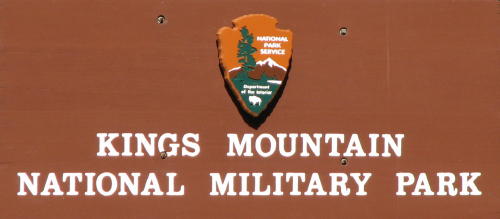 Kings
Mountain National Military Park in located in Blacksburg, South Carolina. At
3,950 acres, is one of the largest military parks in the United States. It
is the site of a significant battle of the Revolutionary War.
Kings
Mountain National Military Park in located in Blacksburg, South Carolina. At
3,950 acres, is one of the largest military parks in the United States. It
is the site of a significant battle of the Revolutionary War. Kings Mountain National Military Park - 2009
Updated: 05/10/09
 Kings
Mountain National Military Park in located in Blacksburg, South Carolina. At
3,950 acres, is one of the largest military parks in the United States. It
is the site of a significant battle of the Revolutionary War.
Kings
Mountain National Military Park in located in Blacksburg, South Carolina. At
3,950 acres, is one of the largest military parks in the United States. It
is the site of a significant battle of the Revolutionary War.
After several years of hostilities only one Southern region remained undisturbed by the Revolutionary War - the southern Appalachians. That peace came to a end as British troops under General Charles Cornwallis occupied large areas of North and South Carolina.
In September 1780, Major Patrick Ferguson raided the mountain town of Kings Mountain. The threatened backwoodsmen joined forces with patriots (whigs) from Virginia, South Carolina and North Carolina. They converged on Kings Mountain, where Maj. Ferguson was camped. Although outnumbered by the trained loyalists (tories), the mountain men advanced steadily against repeated bayonet charges and took the summit.
The mountain men accomplished their mission in little more than an hour. Ferguson was dead. Lost with him was Cornwallis's entire left flank. This militia, fighting on its own terms and in its own way, turned the tide on England's attempt to conquer the South and so, the nation. After several battles, on October 19, 1781 General Cornwallis surrendered to General George Washington in Yorktown.
The 1.5 mile self-guided Battlefield Trail allows you to see both the patriots' and the loyalists' perspective of the battlefield. The trail climbs and turns back across the top of the ridge, where the loyalist forces fought and surrendered.
The
visitor center presented a very well done and informative video related to the
British invasion of the Southern region and this battle in particular.
The
visitor center was set up as a walk through the woods.
Lighting
on this display changed to reveal the interior of a cabin. Text of the signs
says "It is sad that I must leave to joining the battle. But we have worked hard
to make this place our home, and if it means taking arms against the British in
order to keep it that way, I am ready".
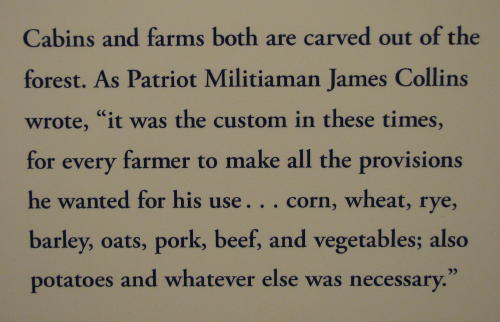
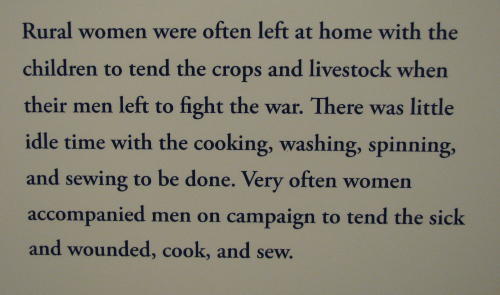
This map shows the troop movement in the region.
On
display were four kinds of canteens used by the solders to carry water - wood,
clay, metal and leather.
This
splintered tree limb has a musket ball imbedded in it. It was found by a local
resident in the 1970s.
Fascinated by firearms, Major Ferguson redesigned the breach loading flintlock
rifle in increase firing speed and the reduced fouling. In wind and rain he
fired a series of four shots per minute while walking and six a minute while
standing.
The breech plug of the Ferguson rifle was open by one turn of the trigger guard. Riflemen could load and fire the weapon in the prone or kneeling position providing less exposure to enemy fire.
Ferguson type weapons and targets . . .
Soldiers equipment . . .
Many
exhibits told stories and discussed battlefield history.
A relief map used LED lights and an audio presentation to gave the history of the battle at Kings Mountain.
Two accounts of the battle . . .
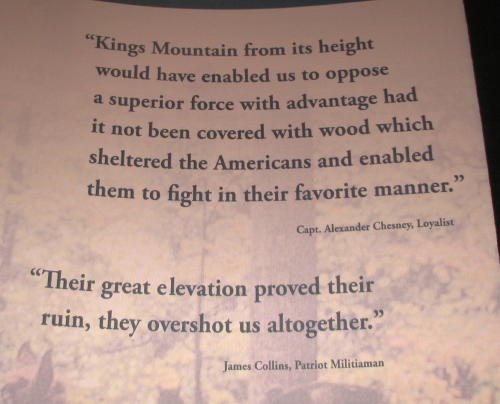

The
Battlefield Trail started and ended outside the rear door of the visitor center.
As you walked the trail, history came alive on the various markers and information boards. We have posted several of the boards along with the words describing the battle at that spot.
The fight for liberty . . .
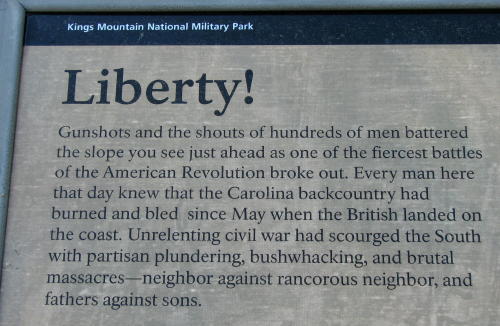
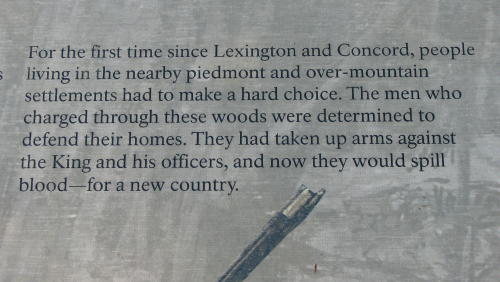
The Carolina Backwoodsmen were an interesting group.
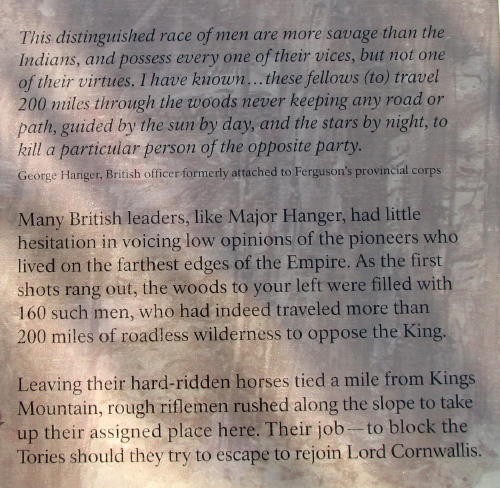
The big story was the fall of Ferguson.




Lieutenant
Colonel James Hawthorn was one of several officers memorialized along the
Battlefield Trail.
In 1815, Dr. William McLean, a former patriot surgeon, organized the first
commemorative ceremony at the battlefield. The 83-foot tall U. S. Monument was
dedicated in 1909.
In 1931, Congress established Kings Mountain National Military Park.
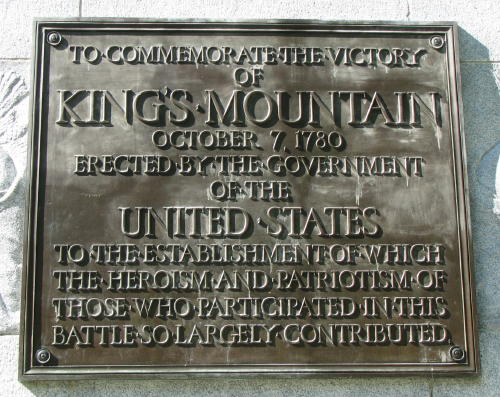
The trail was asphalt for good footing but always uphill or downhill.
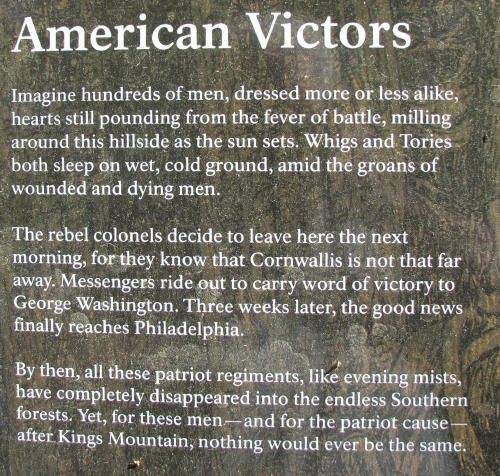
Some of the soldiers went on to careers in politics.
God Save the King!
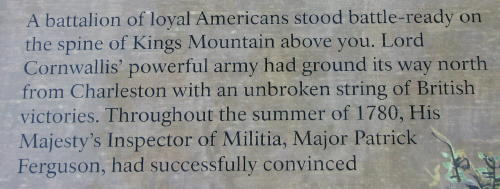


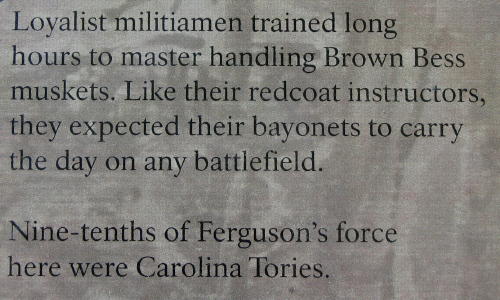
Kings Mountain National Military Park would be a great location to visit for anyone interested in the American Revolutionary War. There is no admission charge. At least three hours should be allotted for your visit.